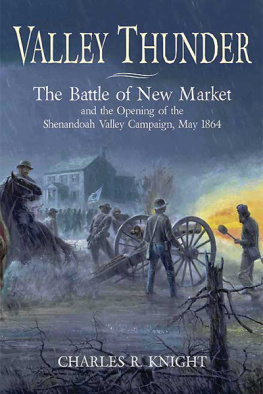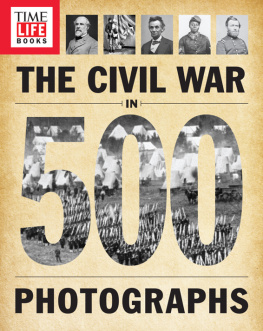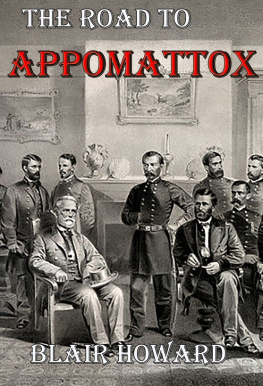F ROM A RLINGTON
TO A PPOMATTOX
Robert E. Lees Civil War, Day by Day, 1861-1865
Charles R. Knight
2021 by Charles R. Knight
All rights reserved. No part of this work may be reproduced, stored in a retrieval system, or transmitted, in any form or by any means, electronic, mechanical, photocopying, recording, or otherwise, without the prior written permission of the publisher.
Library of Congress Cataloging-in-Publication Data
Names: Knight, Charles R., author.
Title: From Arlington to Appomattox: Robert E. Lees Civil War, Day by Day, 1861-1865 / Charles R. Knight. Other titles: Robert E. Lees Civil War
Description: El Dorado Hills : Savas Beatie LLC, 2021. | Includes bibliographical references and index. |
Summary: Lost in all of the military histories of the war, and even in most of the Lee biographies, is what the general was doing when he was out of historys public eye. Focusing on where he was, who he was with, and what he was doing day by day offers an entirely different appreciation for Lee. Readers will come away with a fresh sense of his struggles, both personal and professional, and discover many things about Lee for the first time using his own correspondence and papers from his family, his staff, his lieutenants, and the men of his army. provided by publisher.
Identifiers: LCCN 2020035968 | ISBN 9781611215021 (hardcover) | ISBN 9781611215038 (ebook)
Subjects: LCSH: Lee, Robert E. (Robert Edward), 1807-1870Chronology. | GeneralsConfederate States of AmericaBiography. | Confederate States of America. ArmyBiography. | United States HistoryCivil War, 1861-1865Chronology.
Classification: LCC E467.1.L4 K65 2020 | DDC 973.7/3092 [B]dc23
LC record available at https://lccn.loc.gov/2020035968
First edition, first printing
ISBN-13: 978-161121-502-1
eISBN: 978-1-61121-503-8
Mobi ISBN: 978-1-61121-503-8
Savas Beatie
989 Governor Drive, Suite 102
El Dorado Hills, CA 95762
Phone: 916-941-6896
(E-mail)
Savas Beatie titles are available at special discounts for bulk purchases in the United States by corporations, institutions, and other organizations. E-mail us at for additional information.
For that one particular archivist who could just never understand that yes, I DO in fact really need to see the entire Lee collection

General Robert E. Lee
This photograph was taken by Julian Vannerson in Richmond, Virginia, in early 1864, just before the beginning of the spring campaign that began in the Wilderness, carved its bloody course down to and then beyond the James River to Petersburg, and, nearly 10 months later, finally ended in April 1865 at Appomattox Court House. LOC
Foreword
W riters working in the field of military history probably labor as much for themselves as for any audience. Many of us relish the process: gathering material, wrestling it into some sort of order, interpreting it, and then converting the results of all that labor into prose, captured for posterity on a printed page. That generalization cannot apply to the noble genre of reference work. Compilers toil for everyonefor themselves, certainly, but indisputably, too, for their colleagues and for future users as yet unborn.
A first superficial glance at From Arlington to Appomattox might provoke derisive hoots from certain quarters on the grounds that yet another Robert E. Lee book has arrived to further burden a saturated market. In fact this is no standard biography, nor is it like anything produced before in the comprehensive Lee literature. Instead it is an interpreted collection of factsa gigantic piece of research that addresses all four years of Lees Civil War service in an entirely new and useful way. It inevitably will serve as a keystone source for all future Lee books, and for much other historical work on his army and its campaigns.
When R. E. Lee ascended to command of the Army of Northern Virginia on June 1, 1862, he already had fourteen months of significant wartime duty on his record. That service reached into the mountains of western Virginia and the coastal lowlands of South Carolina and Georgia. Lee also exercised country-wide influence and power from his position in Richmond in the opening months of 1862. Admirable scholarship exists on those topics and on nearly every other feature of the generals Civil War experience, but largely, and almost unavoidably, in thematic isolation.
The day by day concept employed here probably works best for a soldier of broad responsibility. Through this lens we see the vast scope of Lees duties, the multitude of diverse topics that occupied and fretted the general on a daily basis, even in winter quarters. By virtually any standard March 9, 1865, was a pedestrian, now-forgotten day in Virginias Civil War. In From Arlington to Appomattox , we find that, at a minimum, Lee concerned himself with desertion rates among North Carolina soldiers; minor military operations in North Carolina and Virginia; and the overall state of the war effort, especially the critical subject of dwindling supplies. Having accomplished all that via the written word, Lee visited his lines of defense around Petersburg and did not return until after midnight.
In active and mobile operations, that grinding stress grew even greater. When the war entered its fourth spring in Virginia, the pressure on Lee reached previously unseen levels, particularly in May 1864, when he staved off Union offensives on three separate fronts. For years historians have remarked on the physical toll those responsibilities took on a 57-year-old man. On tours across the May battlefields, some of us have cited a remark from the armys medical director, Dr. Lafayette Guild, in which he stated that Lee had not from the 5th to 25th had two hours consecutive sleep. That has been one of the few quantifiable examples of the burden of command on the general. With all the available evidence neatly marshaled here, we can see the exhausting daily routine Lee followed, and can better appreciate its crushing cumulative weight. See, for instance, the reconstruction of his activities on May 21-22, 1864, a period in which the armies moved rather than fought. Lee apparently slept little, if at all, for nearly 48 hours as he coordinated his armys march southward from Spotsylvania. Within a day of that ordeal, sickness felled Lee and famously kept him tent-bound during a critical period of missed opportunities on the North Anna River. The cause and its effect seem startlingly clear in this format.
From Arlington to Appomattox will become the standard reference work on R. E. Lees daily wartime experiences, and should last until the braying Jacobins of our century succeed in devising legislation to make ownership of Confederate-themed books a felony.
Robert E. L. Krick
Glen Allen, Virginia
author of Staff Officers in Gray
Introduction














